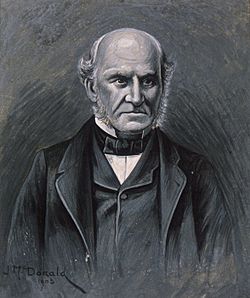James Busby facts for kids
Quick facts for kids
James Busby
|
|
|---|---|
 |
|
| British Resident in New Zealand | |
| In office March 1833 – 28 January 1840 |
|
| Bay of Islands councillor | |
| In office 1853–1855 |
|
| Bay of Islands councillor | |
| In office 1857–1863 |
|
| Personal details | |
| Born | 7 February 1802 Edinburgh,Scotland |
| Died | 15 July 1871 (aged 69) Anerley, London, UK |
| Spouses | Agnes Busby (née Dow; m. 1832) |
James Busby (7 February 1802 – 15 July 1871) was appointed in 1833 as the British Resident in New Zealand, and became involved in drafting both the 1835 Declaration of the Independence of New Zealand and the 1840 Treaty of Waitangi. As British Resident, he acted as New Zealand's first jurist and the "originator of law in Aotearoa", to whom New Zealand owes almost all of its underlying jurisprudence'. Busby is also regarded as the "father" of the Australian wine industry, as he brought the first collection of vine stock from Spain and France to Australia.
Contents
Life
He was born in Edinburgh, Scotland, the son of English engineer John Busby and mother Sarah Kennedy. His family emigrated from Britain to New South Wales in 1824.
On his arrival in Sydney, Busby was appointed a teacher of viticulture at the Male Orphans School at Bald Hills near Liverpool. The school closed in 1850. Busby served out his contract and taught the stipulated two hundred days at the Male Orphans' Farm. Busby then received a Grant of Land from the Governor and after much careful deliberation he chose a block in the Coal River area of the Hunter Region.
In 1831 Busby returned to England, before visiting Spain and France to further his study in viticulture. Busby returned to Australia in 1832.
In New Zealand
Busby married Agnes Dow at Segenhoe, in the Hunter Region, New South Wales, on 1 November 1832. In March 1833 he was appointed by the Colonial Office to the position of British Resident of New Zealand and went to the Bay of Islands where he arrived in H.M.S. Imogene on 5 May that year. Agnes followed him, arriving in July.
A house was completed for him at Waitangi where he planted some of the vine stock he had collected in Europe, from which vineyard wine was being made before his vines were productive in Australia.
His duties were to protect British commerce, control, and to mediate between the unruly Pākehā settlers and Māori in New Zealand. However, he was not provided with any resources to impose this authority.
After an unregistered New Zealand ship was seized in Australia, Busby proposed that New Zealand should have a national flag. A selection of three or four designs was sent from Australia, and Māori chiefs chose one at a meeting at his residency on 20 March 1834; see United Tribes of New Zealand.
Independence and Treaty of Waitangi
In 1835 Busby learned that Baron Charles de Thierry, a Frenchman, was proposing to declare French sovereignty over New Zealand. He drafted the Declaration of the Independence of New Zealand and at a meeting in October signed it together with 35 chiefs from the northern part of New Zealand.
After the arrival of William Hobson in 1840, Busby co-authored with him the Treaty of Waitangi. It was first signed on 5 and 6 February 1840 on the lawn outside his residence. Busby and his family left Waitangi that year. He declined an offer for a position in the new colonial government, and instead focused on farming interests, but became entangled in litigation over his own land titles: the New Zealand Banking Company seized his Waitangi property without giving Busby's debtors an opportunity to pay what they owed, and Governor Grey expropriated Busby's land at Whangārei. He also edited a newspaper and in 1853 was elected a member of the Auckland Provincial Council. As a member of the provincial council, he became an outspoken supporter of establishing Auckland as a separate colony to the rest of New Zealand. Popular opinion at the time went against Busby, and some newspapers claimed his arguments for Auckland's separation were due to his inability to settle land claims with the colonial government.
He contested the 1860 general election for a seat in the House of Representatives for the Bay of Islands electorate, but was unsuccessful.
Later life
He died in 1871 in Anerley, England after travelling back for an eye operation, and is buried at West Norwood Cemetery in London. His wife returned to New Zealand where she died, at Pakaraka in 1889, and is buried at Paihia.
The Waitangi property, on which the Treaty was signed, was derelict until the 1930s, when it was purchased by the Governor-General of the day, Viscount Bledisloe and donated to the nation.
Published writings
- Treatise on the Culture of the Vine (1825)
- A Manual of Plain Directions for Planting and Cultivating Vineyards and for Making Wine in New South Wales (Sydney 1830)
- Journal of a Tour through some of the vineyards of Spain and France (Sydney 1833)
See also
 In Spanish: James Busby para niños
In Spanish: James Busby para niños

